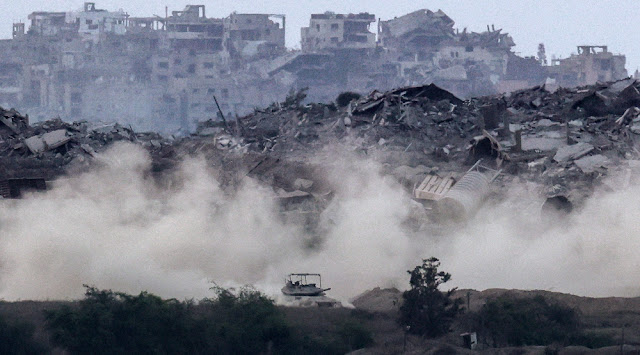Catastrophic Demolition in Gaza: Israeli Military Razes Over 1,500 Homes in al-Zeitoun, Deepening Humanitarian Crisis
In a devastating escalation of the ongoing conflict in the Gaza Strip, the Israeli military has demolished more than 1,500 homes in the al-Zeitoun neighborhood of Gaza City over the past three weeks, according to the Palestinian Civil Defense. The agency’s spokesperson, Mahmoud Bassal, speaking on Thursday, August 28, 2025, revealed that the systematic destruction, which began earlier this month, has reduced entire residential areas to rubble, leaving no buildings standing in the southern part of al-Zeitoun. This campaign, part of an illegal plan approved by the Israeli security cabinet on August 8 to occupy Gaza City, has forced 80 residents to flee to safer areas in western and northern Gaza City, exacerbating the already dire humanitarian crisis in the besieged territory.
The demolitions, carried out using construction machinery and bomb-laden robots, have targeted seven sites daily in al-Zeitoun, with Israeli quadcopters dropping explosives on rooftops to maximize destruction. The operation has not only obliterated homes but also devastated critical infrastructure, including schools, mosques, waterways, pipelines, and water networks, rendering life in the neighborhood nearly impossible. Asem al-Nabih, a spokesperson for the Gaza municipality, described the scale of destruction as catastrophic, noting that the loss of infrastructure has severely undermined the ability of residents to sustain basic living conditions.
The demolition campaign is part of a broader Israeli military offensive in Gaza that has claimed at least 62,895 lives, predominantly women and children, and injured 158,927 others since October 7, 2023, according to the Gaza health ministry. Initiated and driven by Israeli Prime Minister Benjamin Netanyahu, the occupation scheme for Gaza City has drawn widespread international condemnation for its devastating impact on civilians and its violation of international humanitarian law. Nearly two years into what many describe as a genocide in Gaza, the destruction of al-Zeitoun represents a new chapter of bloodshed and forcible displacement, further compounding the suffering of an exhausted and starving population.
This article provides an in-depth examination of the demolitions in al-Zeitoun, the broader context of the Israel-Palestine conflict, the humanitarian and legal implications, and the potential consequences for the region and the international community.
The Demolition Campaign in al-Zeitoun: A Systematic Assault
The Palestinian Civil Defense’s report of over 1,500 homes demolished in al-Zeitoun since early August 2025 paints a grim picture of the Israeli military’s operations in Gaza City. According to Mahmoud Bassal, the agency’s spokesperson, the destruction has been methodical, with Israeli forces employing construction machinery, bomb-laden robots, and quadcopters to target residential areas. The use of explosives dropped from drones has been particularly devastating, leveling homes and reducing entire neighborhoods to rubble. The southern part of al-Zeitoun, once a vibrant residential area, now stands as a wasteland, with no buildings left intact.
The scale of the demolitions is staggering, with an average of seven sites targeted daily. This systematic approach suggests a deliberate strategy to render the area uninhabitable, forcing residents to flee. Bassal reported that 80 residents of al-Zeitoun have been displaced to western and northern areas of Gaza City, joining the millions of Palestinians who have been uprooted since the onset of the conflict. These displacements add to the already overwhelming burden on Gaza’s limited resources, as safe zones in the west and north are overcrowded and lack adequate shelter, food, and medical facilities.
Asem al-Nabih, a Gaza municipality spokesperson, provided further insight into the broader impact of the demolitions. Beyond the loss of homes, the destruction of schools, mosques, waterways, pipelines, and water networks has crippled the neighborhood’s infrastructure. “The destruction is far greater than just the buildings in this neighborhood,” al-Nabih said. “Most of the infrastructure and residential areas, schools, mosques, waterways, and even pipelines and water networks have been severely damaged, which makes life and living here almost impossible.” This comprehensive devastation has left al-Zeitoun residents without access to basic necessities, further deepening the humanitarian crisis.
The demolitions are part of a broader Israeli military strategy approved by the security cabinet on August 8, 2025, to occupy Gaza City. The plan, pushed by Prime Minister Benjamin Netanyahu, has been condemned as illegal under international law, which prohibits the destruction of civilian property during armed conflicts unless absolutely necessary for military purposes. Critics argue that the scale and nature of the demolitions in al-Zeitoun suggest a policy of collective punishment, aimed at displacing Palestinians and altering the demographic and territorial landscape of Gaza.
Historical and Geopolitical Context of the Conflict
The demolition of al-Zeitoun is the latest chapter in the long-standing Israel-Palestine conflict, which has its roots in the early 20th century and the competing national aspirations of Israelis and Palestinians. The Gaza Strip, a 141-square-mile territory home to over two million Palestinians, has been under a blockade imposed by Israel and Egypt since 2007, following Hamas’s takeover of the territory. The blockade has restricted the movement of goods and people, leading to widespread poverty, unemployment, and a chronic humanitarian crisis.
The current conflict escalated dramatically on October 7, 2023, when Hamas launched a surprise attack on southern Israel, killing approximately 1,200 people and taking over 200 hostages. Israel’s response, characterized by intense airstrikes and a ground invasion, has been one of the most destructive military campaigns in the region’s history. The Gaza health ministry reports that, as of August 28, 2025, at least 62,895 Palestinians, mostly women and children, have been killed, and 158,927 others injured. The destruction of infrastructure, including hospitals, schools, and water systems, has left Gaza on the brink of collapse.
The occupation scheme for Gaza City, approved on August 8, 2025, represents a significant escalation in Israel’s strategy. The Israeli military has characterized Gaza City as a stronghold of Hamas, the Palestinian resistance movement that governs the territory. However, the targeting of civilian neighborhoods like al-Zeitoun, with no apparent military justification, has raised concerns about the proportionality and legality of Israel’s actions. The systematic demolition of homes and infrastructure suggests a broader objective of rendering large parts of Gaza uninhabitable, potentially paving the way for further territorial control or displacement of Palestinians.
The conflict is deeply embedded in regional and international geopolitics. Israel’s military operations are supported by key allies, notably the United States, which provides significant military and financial aid. However, the scale of civilian casualties and the humanitarian crisis have strained Israel’s relations with other global actors, including the United Nations, European countries, and human rights organizations, which have called for an immediate ceasefire and increased humanitarian aid. The regional dynamics are further complicated by the involvement of actors such as Iran, which supports Hamas, and Egypt and Qatar, which have mediated ceasefire negotiations with limited success.
Humanitarian Crisis: A Devastating Toll on Civilians
The demolition of over 1,500 homes in al-Zeitoun is just one facet of the broader humanitarian catastrophe in Gaza. The Gaza health ministry’s figures—62,895 deaths and 158,927 injuries since October 2023—highlight the staggering human cost of the conflict, with women and children disproportionately affected. The destruction of critical infrastructure, as described by al-Nabih, has made life in Gaza increasingly untenable. The loss of schools has disrupted education for hundreds of thousands of children, while the destruction of hospitals and clinics has left the healthcare system in tatters, with facilities like Nasser Hospital in Khan Younis struggling to cope with the influx of casualties.
The displacement of 80 residents from al-Zeitoun is part of a larger pattern of forced migration, with nearly the entire population of Gaza—over two million people—displaced at least once since October 2023. The areas to which residents are fleeing, such as western and northern Gaza City, are already overcrowded and lack adequate resources. The United Nations has warned that Gaza is on the brink of famine, with malnutrition rates soaring, particularly among children. Access to clean water, electricity, and medical supplies is severely limited, exacerbating the suffering of an already exhausted and starving population.
The psychological toll of the conflict is immense. Survivors, particularly children, are grappling with trauma from the constant threat of violence, the loss of loved ones, and the destruction of their homes and communities. The systematic demolition of neighborhoods like al-Zeitoun not only destroys physical structures but also erases cultural and social landmarks, further undermining the resilience of Gaza’s population. The long-term implications for recovery and rebuilding are daunting, as the scale of destruction will require billions of dollars and decades of effort to address.
International Legal Scrutiny and Accountability
The demolitions in al-Zeitoun and the broader Israeli offensive in Gaza have drawn significant international legal scrutiny. In November 2024, the International Criminal Court (ICC) issued arrest warrants for Israeli Prime Minister Benjamin Netanyahu and former Minister of Military Affairs Yoav Gallant, citing evidence of war crimes and crimes against humanity in Gaza. The warrants specifically point to the systematic targeting of civilian infrastructure and the use of disproportionate force, both of which are evident in the al-Zeitoun demolitions. Israel has rejected the ICC’s jurisdiction, arguing that the court is biased and that its actions are a legitimate response to Hamas’s attacks.
Additionally, Israel faces a genocide case at the International Court of Justice (ICJ), initiated by South Africa in December 2023. The case alleges that Israel’s actions in Gaza, including the mass killing of civilians and the destruction of infrastructure, constitute genocide under the 1948 Genocide Convention. The ICJ has issued preliminary orders calling for Israel to prevent genocidal acts and ensure humanitarian access to Gaza, but a final ruling is still pending. The demolitions in al-Zeitoun, which have rendered entire neighborhoods uninhabitable, are likely to be cited as evidence in the case, further intensifying international pressure on Israel.
The legal proceedings at the ICC and ICJ represent a significant shift in the global response to the Israel-Palestine conflict. While Israel has historically enjoyed strong support from Western allies, particularly the United States, the scale of the current crisis has led to growing calls for accountability. Human rights organizations, such as Amnesty International and Human Rights Watch, have documented extensive violations of international humanitarian law, including the deliberate targeting of civilian infrastructure and the use of excessive force. The demolitions in al-Zeitoun, described as systematic by Palestinian officials, are likely to feature prominently in these reports.
Diplomatic Efforts and Global Reactions
Diplomatic efforts to secure a ceasefire in Gaza have been largely unsuccessful, with negotiations mediated by Egypt and Qatar repeatedly stalling. The United States, while calling for restraint, has continued to provide military support to Israel, vetoing UN Security Council resolutions for an immediate ceasefire. This stance has drawn criticism from other global actors, including the European Union and several Arab states, which have called for an end to the violence and increased humanitarian aid.
Public opinion worldwide has been deeply divided, with protests in major cities calling for an end to the violence and justice for Palestinians. The destruction of al-Zeitoun and the broader offensive in Gaza have galvanized international solidarity movements, with activists and organizations demanding accountability for Israel’s actions. The growing legal and diplomatic pressure, combined with grassroots activism, has placed Israel in an increasingly precarious position on the global stage.
Regional Implications and the Risk of Escalation
The demolition campaign in al-Zeitoun and the occupation scheme for Gaza City have significant implications for the broader Middle East. The conflict has heightened tensions with regional actors such as Iran, which provides support to Hamas and other Palestinian resistance groups. The destruction in Gaza could also destabilize neighboring countries, such as Egypt and Jordan, which are already grappling with the economic and political fallout of the conflict.
The occupation of Gaza City, if fully implemented, risks further entrenching the conflict and undermining prospects for a two-state solution. The systematic destruction of neighborhoods like al-Zeitoun suggests a strategy aimed at altering the demographic and territorial realities of Gaza, potentially paving the way for annexation or long-term control. Such actions would likely provoke a strong response from Palestinian factions and their allies, increasing the risk of a broader regional escalation.
The Path Forward: Challenges and Opportunities
The demolition of over 1,500 homes in al-Zeitoun is a stark reminder of the human cost of the Israel-Palestine conflict. For the residents of Gaza, the immediate priority is survival amidst ongoing violence and a collapsing humanitarian system. The international community faces the urgent challenge of securing a ceasefire, delivering humanitarian aid, and addressing the root causes of the conflict. The scale of destruction in Gaza, coupled with the blockade and ongoing military operations, has created a humanitarian crisis of unprecedented proportions.
For Israel, the continued offensive risks further international isolation, particularly as legal proceedings at the ICC and ICJ progress. The arrest warrants for Netanyahu and Gallant, combined with the genocide case, could limit the travel of senior officials and strain diplomatic relations with key allies. Domestically, the Israeli government faces pressure from its citizens, with protests calling for the release of hostages held by Hamas and a resolution to the conflict.
For Palestinians, the long-term prospects for recovery are daunting. The destruction of infrastructure, including homes, schools, and hospitals, will require massive investment and international support to rebuild. The psychological and social toll of the conflict, particularly on children, will have lasting consequences for Gaza’s future. Efforts to address these challenges must prioritize humanitarian aid, reconstruction, and a political process that addresses the underlying issues of occupation, blockade, and displacement.
Conclusion
The demolition of over 1,500 homes in al-Zeitoun, Gaza City, by the Israeli military since early August 2025 represents a catastrophic escalation in the ongoing conflict. The systematic destruction, carried out with construction machinery, bomb-laden robots, and quadcopters, has left entire neighborhoods in rubble, displaced residents, and devastated critical infrastructure. The campaign, part of an illegal plan to occupy Gaza City, has deepened the humanitarian crisis in Gaza, where 62,895 Palestinians have been killed and 158,927 injured since October 2023.
The international response, including ICC arrest warrants and an ICJ genocide case, reflects growing scrutiny of Israel’s actions, but diplomatic efforts to secure a ceasefire remain elusive. The demolitions in al-Zeitoun underscore the urgent need for humanitarian intervention, civilian protection, and a path toward a just and lasting resolution to the Israel-Palestine conflict. As Gaza faces an uncertain future, the international community must confront the moral and legal imperatives of addressing one of the most pressing crises of our time.






